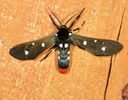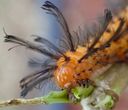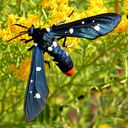Syntomeida
Syntomeida
Classification
- Phylum: Arthropoda
- Subphylum: Hexapoda
- Class: Insecta
- Order: Lepidoptera
- Superfamily: Noctuoidea
- Family: Erebidae
- Subfamily: Arctiinae
- Tribe: Arctiini
- Subtribe: Euchromiina
- Genus: Syntomeida
Pronunciation
How to pronounce Syntomeida: /ˌsɪntəˈmaɪdə/
These audio files are automatically generated. While they are not always 100% accurate, they are a good starting point.
Images






Summary
Syntomeida epilais, commonly known as the polka-dot wasp moth or oleander moth, is a moth species known for its gluttonous caterpillar stage, which primarily feeds on the oleander plant. This species is characterized by its striking coloration and is notable for its mimicry of wasps, which provides it some protection from predators.
Physical Characteristics
Dark metallic blue with white polka-dots on the wings and upper abdomen; tip of the abdomen is bright red. Caterpillars are orange or dark orange with long black hairs.
Habitat
Neotropic areas, particularly common in Florida and surrounding regions where oleander plants are present.
Distribution
Native to the Caribbean, common in Florida, seen as far north as South Carolina, and west to Mississippi and Texas.
Diet
Larvae primarily feed on oleander plants and may also feed on devil's potato and desert rose plants.
Life Cycle
Eggs are laid in groups of 12 to 75 on the undersides of oleander leaves; caterpillars undergo growth stages before metamorphosing into moths.
Reproduction
Females contact males through ultrasonic signals. After mating, females lay eggs on suitable host plants.
Ecosystem Role
Larvae can impact oleander plant populations and potentially other plants they feed on.
Economic Impact
Can cause damage to oleander plants, possibly affecting ornamental plant industries and landscaping.
Health Concerns
Caterpillars are harmless to humans despite their appearance; the setae do not inflict harm.
Similar Taxa
Misconceptions
Mimics wasp appearance leading to assumptions of being harmful despite being harmless.
Tags
- moth
- insect
- Lepidoptera
- wasp mimicry
- pest